Giochi dell'Oca e di percorso
(by Luigi Ciompi & Adrian Seville)
(by Luigi Ciompi & Adrian Seville)

|
Giochi dell'Oca e di percorso
(by Luigi Ciompi & Adrian Seville) |

|
 |

Torna alla ricerca giochi (back to game search) |
 |
| Swan (The) of Elegance. A New Game. Designed for the Instruction & Amusement of Youth. | ||
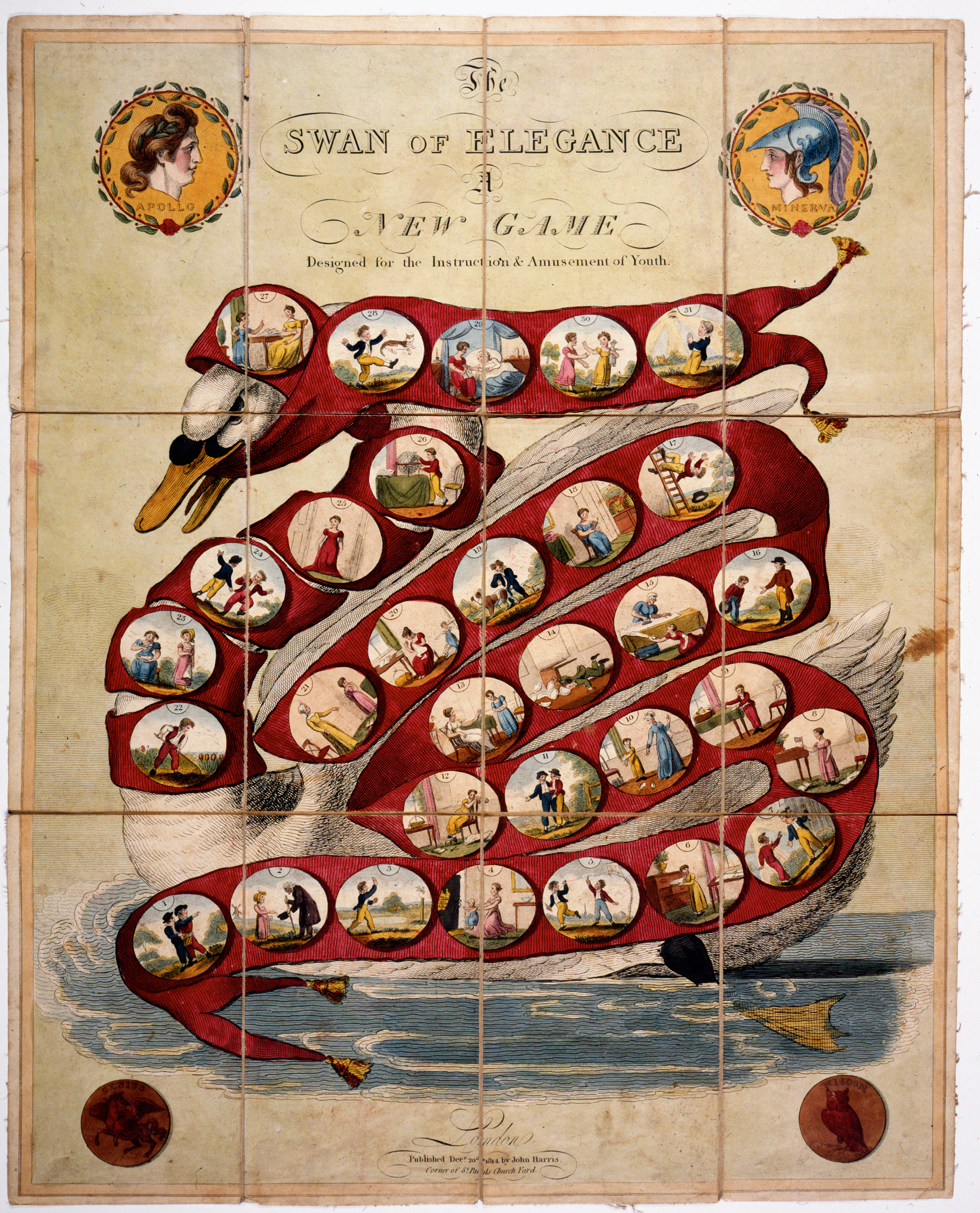 |
Versione stampabile
 |
Invia una segnalazione

|
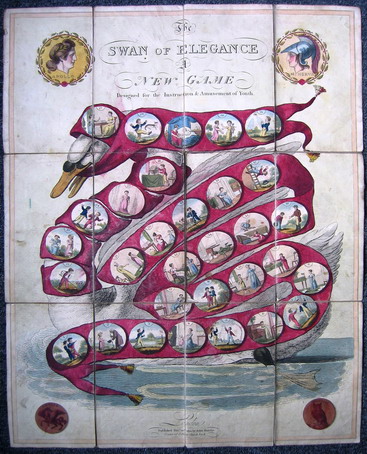  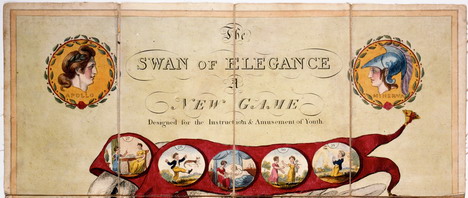  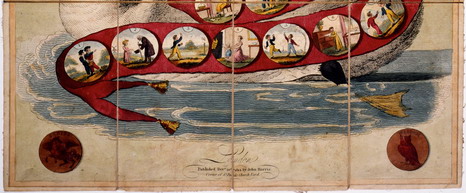  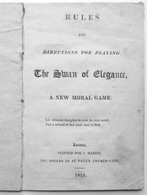 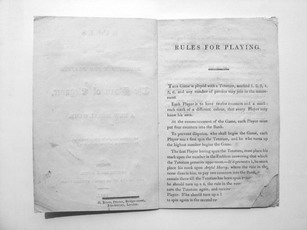  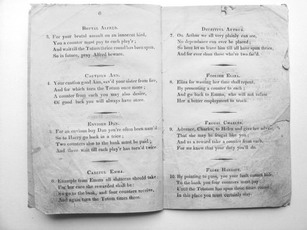 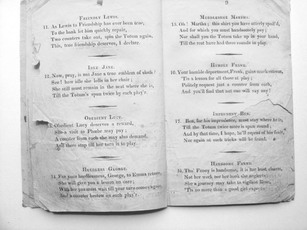 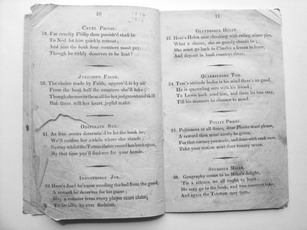 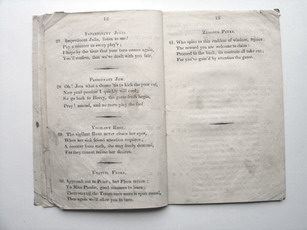 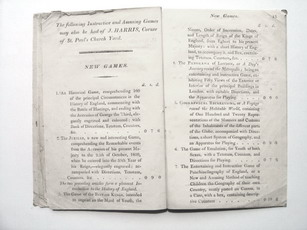 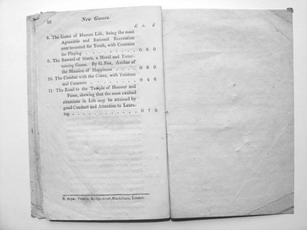 |
primo autore: | Anonimo |
| secondo autore: | Harris John | |
| anno: | 1814/15 | |
| luogo: |
Inghilterra-Londra |
|
| periodo: | XIX secolo (1°/4) | |
| percorso: | Percorso di 31 caselle numerate | |
| materiale: | carta incollata su tela (engraving on paper with linen backing) | |
| dimensioni: | 588X469 | |
| stampa: | Litografia colorata a mano (hand-coloured engraving) | |
| luogo acquisto: | ||
| data acquisto: | ||
| dimensioni confezione: | ||
| numero caselle: | 31 | |
| categoria: | Infanzia, educazione, pedagogia, favole e fiabe | |
| tipo di gioco: | Gioco di percorso | |
| editore: | Published by John Harris, Corner of S.t Paul Church Yard | |
| stampatore: | Published by John Harris Corner of S.t Pauls Church Yard | |
| proprietario: | Collezione E. C. - A. Seville | |
| autore delle foto: | A. Seville - E. C. | |
| numero di catalogo: | 1120 | |
| descrizione: |
Gioco di 31 caselle numerate distribuite sul corpo di un cigno. Titolo al centro in alto: "The Swan of Elegance: A New Game Designed for the Instruction and Amuseument of Youth". Negli angoli: Apollo, Minerva, Genius, Wisdom. Scene di bambini che si comportano bene o male sono disposte lungo un nastro cremisi che adorna un meraviglioso cigno. Per ciascuna di esse il regolamento riporta un versetto moralizzante; per la casella 23 che mostra l'Avida Helen, si legge "Ecco Helen che quasi si strozza mangiando delle minces pies (dolce tradizionale inglese)/ Che peccato che debba essere così ingorda;/Devo tornare da Charles per imparare un lezione/E depositare tre gettoni al banco". In effetti alla casella 9 troviamo il Parsimonioso Charles intento a tagliare una fettina molto sottile di una torta glassata. La casella 10 è la Falsa Harriot che ha rotto un piatto ma sta cercando di incolpare il gatto. Il tentativo di inganno però non va a buon fine, infatti deve pagare quattro gettoni al banco e saltare tre turni. In basso al centro: "LONDON Published Dec.r 20 1814 by John Harris, Corner of S.t Paul Church Yard". REGOLE: non riportate sul tavoliere. CASELLE: mute. NOTA: vedi esemplare Collezione British Museum (Arch. n°2420) REFERENZA 1 "British Museum" - AN323000001© The Trustees of the British Museum 1893, 0331. 128 Title: "The Swan of Elegance: A New Game Designed for the Instruction and Amuseument of Youth". Materials: paper Techniques: hand-coloured etching Production person: Published by John Harris Production place: Published in London Date: 1814 Schools /Styles: British Description: Game-board in the shape of a swan with 31 numbered pictorial compartments, each showing a child engaged in a moral or an immoral deed, explained in the rule book with four lines of verse for each compartment Medaliions at each corner, representing Apollo, Minerva, Wisdom and Genius. Acompanied by a 16 page rule booklet, which also lists other games sold by John Harris, and kept in a board slip-case bearing a printed label. 1814. Hand-coloured etching backed on linen. Inscription Content: Lettered with title at top and publication details at bottom Dimensions: Height: 588 millimetres; Width: 469 millimetres. Subject: education REFERENZA 2 WHITEHOUSE, Francis Reginald Beaman, (pag. 49-50): THE SWAN OF ELEGANCE. Published by Harris in circa 1815. The design of the game consists of 31 circular spaces, each containing a picture of a good or bad child. It is played with teetotum and counters, and an accompanying booklet gives the rules of the game and provides a verse for each space, e.g.: “Idle Jane, Now, pray, is not Jane a true emblem of sloth? See! how idle she lolls in her chair; She still must remain in the seat where she is Till the Totum’s spun twice by each play’r.” “Humble Frank Your humble deportment, Frank, gains much esteem, "Tis a lesson for all those at play; Politely request just a counter from each, And you’ll find that not one will say nay!" The game culminates with “Zealous Peter", who scoops the pool! REFERENZA 3 Game 33: The Swan of Elegance The Swan of Elegance – a new moral game. London: John Harris, Corner of St. Paul’s Church Yard, December 20th 1814. Copper engraving with original hand color, 58 x 47 cm., dissected and laid onto linen with 4 x 4 panels. Refs.: Ciompi/Seville 1120; Whitehouse, pp. 49 - 50. This ”moral” game shows no influences from earlier French traditions. The 31 circular spaces, drawn on a tasselled scarf that envelops a magnificent swan, each contain an image of either a good child or of a bad child. At the top of the engraved game sheet are medallions of Apollo and Minerva, with corresponding medallions to Genius and Wisdom at the bottom. The rule booklet on its title page has the couplet: ”Let virtuous thoughts be ever in your mind / And a reward at last your (sic) sure to find.” The booklet provides a sharply written moral verse for each space, e.g., Space 12: Idle Jane - Now, pray, is not Jane a true emblem of sloth? / See! How idle she lolls in her chair; She still must remain in the seat where she is, /Till the Totum’s spun twice by each play’r. Space 15: Meddlesome Martha - Oh! Martha; this shirt you have utterly spoil’d, / And for which you must handsomely pay; / Nor shall you the Totum take up in your hand, / Till the rest have had three rounds to play. Space 18: Handsome Fanny - Tho’ Fanny is handsome, it is her least charm, / Not her work, nor her book she neglects. She a journey may take to vigilant Rose / ‘Tis no more than a good girl expects. Space 23: Gluttonous Helen - Here’s Helen near choking with eating mince pies / What a shame, she so greedy should be; / She must go back to Charles a lesson to learn / And deposit in bank counters three. Space 31: Zealous Peter - Who spins to this emblem of wisdom, rejoice: / The reward you are welcome to claim: / Proceed to the bank, its contents take out; / For you’ve gained by attention the game. John Harris (1756 - 1846) was a bookseller, publisher and toyman, known principally for his early development of illustrated children’s books. He acquired the celebrated Newbery business in 1801, after acting as manager to Elizabeth Newbery (1746 -1821), the leading juvenile publisher of the period. (Adrian Seville) REFERENZA 4 The Morgan Library & Museum. Exhibitions: - "The Royal Game of the Goose four hundred years of printed Board Games". Exhibition at the Grolier Club, February 23 - May 14, 2016 (Prof. Adrian Seville). |
|
| bibliografia: |
1) WHITEHAUSE, F.R.B.: "Table Games of Georgian and Victorian Days", London, Peter Garnett, 1951. 2) GOODFELLOW, Caroline: "A Collector's Guide to Games and Puzzles". Secaucus, New Jersey, Chartwell Books-London, Quintet Publishing Limited 1991. 3) GOODFELLOW, Caroline: "The Development of the English Board Game, 1770-1850", in Board Games Studies 1, 1998. 4) GOODFELLOW, Caroline: "Jeux de société. Le guide du collectionneur des jeux de société depuis le XVIIIe siècle jusqu’à nos jours", (Edizione francese) Carrousel MS, 2001. 5) SEVILLE, Adrian: "The Game of Goose: and its influence on cartographical race games" Journal of the International Map Collectors' Society, Winter 2008 N°115 2008. 6) SEVILLE, Adrian: "The geographical Jeux de l'Oie of Europe." In "Belgeo" 2008 3-4 2008. 7) GOODFELLOW, Caroline: "How We Played: Games From Childhood Past", History Press, 2012. 8) QUINN, Brian - CARTWRIGHT, William: "Geographic Board Games". Geospatial Science Research 3. School of Mathematical and Geospatial Science, RMIT University, Australia. December 2014. 9) SEVILLE, Adrian: "The Royal Game of the Goose four hundred years of printed Board Games". Catalogue of an Exhibition at the Grolier Club, February 23 - May 14, 2016. 10) LIMAN, Ellen: "Georgian and Victorian Board Games: The Liman Collection", Pointed Leaf Press, 2017. 11) NORCIA, Megan A.: "Gaming Empire in Children's British Board Games, 1836-1860". Studies in Childhood, 1700 to the Present. Routledge, 2019. 12) SEVILLE, Adrian: "L'arte dei giochi da tavolo. Oltre un secolo di storia e divertimento dalla fine del Settecento all'inizio del Novecento." Edizioni White Star, 2019. 13) PARLAK, Omer Fatih: "Seafearing through the Perspective of Historic Board Games", in DGSM, Köllen Druck+Verlag, Bonn 2020. |
|
| "The Development of the English Board Game, 1770-1850" (Caroline G. Goodfellow) | ||
| Games of Moral Improvement. "Table Games of Georgian and Victorian Days". (Francis Reginald Beaman, Whitehause) | ||
Vai alla ricerca giochi Vai all'elenco autori